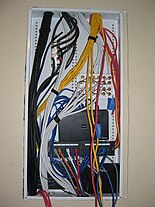LonWorks
This article has multiple issues.Please helpimprove itor discuss these issues on thetalk page.(Learn how and when to remove these template messages)
|
LonWorksorLocal Operating Networkis an open standard (ISO/IEC 14908) for networking platforms specifically created to address the needs of control applications. The platform is built on a protocol created byEchelon Corporationfor networking devices over media such astwisted pair,power lines,fiber optics,andwireless.It is used for the automation of various functions within buildings such aslightingandHVAC;seebuilding automation.
Origins and uptake[edit]
The technology had its origins with chip designs, power lines,twisted pairs,signaling technology,routers,network management software, and other products fromEchelon Corporation.In 1999 the communications protocol (then known asLonTalk) was submitted toANSIand accepted as a standard for control networking (ANSI/CEA-709.1-B). Echelon's power line andtwisted pairsignaling technology were also submitted toANSIfor standardization and acceptance. Since then, ANSI/CEA-709.1 has been accepted as the basis for IEEE 1473-L (in-train controls),AARelectro-pneumatic braking systems for freight trains,IFSF(European petrol station control),SEMI(semiconductor equipment manufacturing), and in 2005 asEN 14908(European building automation standard). The protocol is also one of several data link/physical layers of theBACnetASHRAE/ANSIstandard forbuilding automation.
Chinaratified the technology as a national controls standard, GB/Z 20177.1-2006, and as a building and intelligent community standard, GB/T 20299.4-2006; and in 2007 CECED, the European Committee of Domestic Equipment Manufacturers, adopted the protocol as part of its Household Appliances Control and Monitoring – Application Interworking Specification (AIS) standards.
In 2008,ISOandIECgranted the communications protocol, twisted pair signaling technology, power line signaling technology, andInternet Protocol(IP) compatibility standard numbers ISO/IEC 14908-1, -2, -3, and -4.[1]
Usage[edit]
By 2010, approximately 90 million devices were installed with LonWorks technology. Manufacturers in a variety of industries including building, home, street lighting, transportation, utility, and industrial automation have adopted the platform as the basis for their product and service offerings. Statistics as to the number of locations using the LonWorks technology are scarce, but products and applications built on top of the platform include such diverse functions as embedded machine control, municipal and highway/tunnel/street lighting, heating and air conditioning systems, intelligent electricity metering, subway train control, building lighting, stadium lighting and speaker control, security systems, fire detection and suppression, and newborn location monitoring and alarming, as well as remote power generation load control.
Technical details[edit]
Two physical-layer signaling technologies,twisted pairfree topologyand power-line carrier, are typically included in each of the standards created around the LonWorks technology. The two-wire layer operates at 78 kbit/s usingdifferential Manchester encoding,while the power line achieves either 5.4 or 3.6 kbit/s, depending on frequency.[2]
Additionally, the LonWorks platform uses an affiliated IP tunneling standard—ISO/IEC 14908-4[3](ANSI/CEA-852)[4]—in use by a number of manufacturers[5]to connect the devices on previously deployed and new LonWorks platform-based networks to IP-aware applications or remote network-management tools. Many LonWorks platform-based control applications are being implemented with some sort of IP integration, either at the UI/application level or in the controls infrastructure. This is accomplished with Web services or IP-routing products available in the market.
An Echelon Corporation-designedICconsisting of several 8-bit processors, theNeuron chipwas initially the only way to implement a LonTalk protocol node and is used in the large majority of LonWorks platform-based hardware. Since 1999, the protocol has been available for general-purpose processors: A port of the ANSI/CEA-709.1 standard to IP-based or 32-bit chips.[6]
Applications using LonWorks[edit]
- Semiconductormanufacturing
- Lighting control systems
- Energy management systems
- Heating/ventilation/air-conditioning systems
- Security systems
- Home automation
- Consumer appliance controls
- Public street lighting, monitoring, and control
- Petrol station control
- Electronically controlled pneumatic braking
- Distributed avionics[7]
SNVTs (Standard Network Variable Types)[edit]
One of the keys to the interoperability of the system is the standardisation of the variables used to describe physical things to LonWorks. This standards list is maintained by LonMark International, and each standard parameter is known as Standard Network Variable Type (SNVT, pronounced "sniv-it." ) For example, a thermostat might report temperature using theSNVT_temp,defined as a 2-byte integer between zero and 65535, and representing a temperature between-274.0and 6279.5 degrees Celsius at a precision of 0.1 °C.[8]
References[edit]
- ^"LonWorks Technology Achieves ISO/IEC Standardization"(Press release). 2008-12-03.Retrieved2014-02-11.
- ^http://www.echelon.com/support/documentation/manuals/transceivers/005-0154-01D.pdfArchived2007-09-27 at theWayback MachinePL3120/3150 transceiver data book, p5
- ^http://www.iso.org/iso/iso_catalogue/catalogue_tc/catalogue_detail.htm?csnumber=50360IP Tunneling Protocol (International)
- ^"CTA-852.1: Enhanced Protocol for Tunneling Component Network Protocols over Internet Protocol Channels".
- ^http://www.lonmark.org/membership/directory/Archived2019-08-30 at theWayback MachineDirectory of LonMark International Member Companies
- ^"CTA-709.1: Control Network Protocol Specification".
- ^"The ARNAV FMS 7000 Flight Management System".Aircraft Engineering and Aerospace Technology.65(5): 16. 1993.doi:10.1108/eb037379.
- ^LONMARK® SNVT Master List(PDF)(Version 11, Revision 2 ed.). Echelon Corporation. May 2002. p. 118.Retrieved9 March2020.

